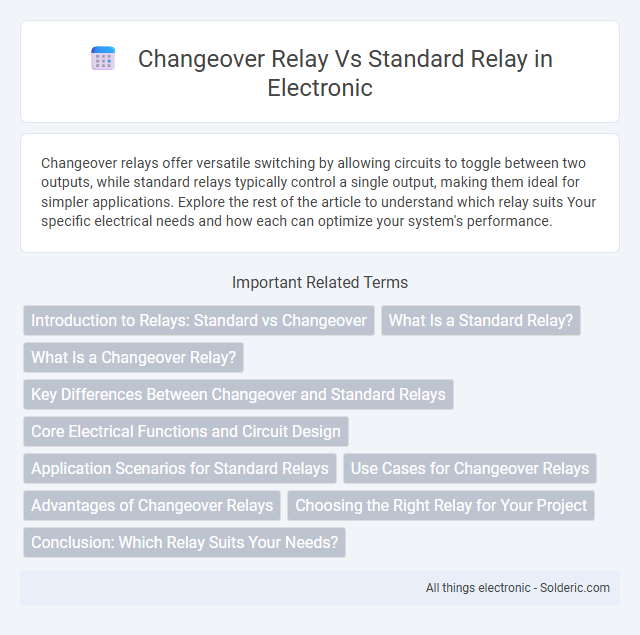Changeover relays offer versatile switching by allowing circuits to toggle between two outputs, while standard relays typically control a single output, making them ideal for simpler applications. Explore the rest of the article to understand which relay suits Your specific electrical needs and how each can optimize your system's performance.
Comparison Table
| Feature | Changeover Relay | Standard Relay |
|---|---|---|
| Contact Type | Single-Pole Double-Throw (SPDT) | Single-Pole Single-Throw (SPST) or Double-Throw (DPDT) |
| Functionality | Switches between two circuits; common pin changes contact | Activates or deactivates a single circuit |
| Applications | Selecting between power sources, audio switching, control logic | Basic switching, power control, on/off systems |
| Contact Configuration | Normally Closed (NC) and Normally Open (NO) contacts available simultaneously | Only Normally Open (NO) or Normally Closed (NC) |
| Complexity | More complex due to additional contacts | Simpler, fewer contacts |
| Cost | Generally higher due to added functionality | Lower cost for basic switching tasks |
| Typical Coil Voltage | Varies widely: 5V, 12V, 24V DC common | Similar range: 5V, 12V, 24V DC common |
Introduction to Relays: Standard vs Changeover
Standard relays operate by opening or closing a single circuit to control electrical devices, typically switching one load on or off. Changeover relays, also known as double-throw relays, provide the ability to switch between two circuits, enabling one input to connect to one of two outputs. This key distinction allows changeover relays to offer greater versatility in complex control systems where multiple circuit options are needed.
What Is a Standard Relay?
A standard relay is an electromechanical switch used to control a high-power circuit with a low-power signal, typically featuring two terminals: common (COM) and normally open (NO). It allows current to flow only when the coil is energized, making it ideal for simple on/off applications. Your system benefits from a standard relay by providing reliable isolation between control and load circuits.
What Is a Changeover Relay?
A changeover relay, also known as a double-throw relay, switches between two output circuits, allowing one common input to connect to either of two outputs. This design contrasts with a standard relay, which typically controls a single circuit, offering either an open or closed connection. Your control system benefits from changeover relays by enabling seamless switching between power sources or signal paths without manual intervention.
Key Differences Between Changeover and Standard Relays
Changeover relays feature a double-throw configuration allowing a single coil to switch between two different circuits, providing versatility in controlling multiple outputs. Standard relays typically have a single throw, either normally open (NO) or normally closed (NC), designed for simple switching tasks. The key difference lies in the contact arrangement and switching capability, with changeover relays offering more complex control options compared to the straightforward on/off operation of standard relays.
Core Electrical Functions and Circuit Design
Changeover relays, also known as double-throw relays, feature a common terminal that switches between normally open (NO) and normally closed (NC) contacts, enabling seamless control of two separate circuits within a single device. Standard relays typically operate with a single set of contacts, either NO or NC, for straightforward circuit interruption or connection. In circuit design, changeover relays offer enhanced versatility for selecting alternate signal paths or outputs, while standard relays provide simpler switching suitable for basic on/off applications.
Application Scenarios for Standard Relays
Standard relays are widely used in applications requiring simple switching with two states, such as turning a device on or off, controlling lighting circuits, and activating motor starters. They are ideal for scenarios where a single output needs to be energized or de-energized without needing to switch between multiple outputs. Your electrical projects benefit from the reliability and straightforward design of standard relays in systems like HVAC controls, automotive circuits, and basic automation tasks.
Use Cases for Changeover Relays
Changeover relays are essential in applications requiring seamless switching between two circuits, such as in backup power systems where you switch from the main power to a generator. These relays are also widely used in control circuits for industrial machinery to alternate between different operational modes. Your choice of changeover relays ensures reliable circuit isolation and prevents simultaneous connection, which is critical for safety and equipment protection.
Advantages of Changeover Relays
Changeover relays offer the advantage of switching between two circuits, allowing for greater flexibility and control in electrical systems compared to standard relays that only connect or disconnect a single circuit. Their ability to toggle between normally open (NO) and normally closed (NC) contacts provides improved functionality for applications requiring alternate power sources or backup systems. Your electrical projects benefit from enhanced reliability and versatility when using changeover relays in complex control scenarios.
Choosing the Right Relay for Your Project
Selecting the right relay for your project depends on the switching requirements and contact configuration; changeover relays offer versatile double-throw contacts for controlling two circuits with one coil, while standard relays typically provide single-throw contacts for simpler switching tasks. Changeover relays are ideal when you need to alternate between two outputs or inputs, ensuring seamless signal or power transfer without interruption. Your choice should prioritize the relay's contact arrangement, coil voltage, and load capacity to ensure reliable and efficient operation in your specific application.
Conclusion: Which Relay Suits Your Needs?
Changeover relays offer versatile switching capabilities by allowing connections between multiple circuits, making them ideal for complex control systems requiring flexible circuit selection. Standard relays provide straightforward on/off control, best suited for simple applications where single-circuit switching suffices. Choosing between changeover and standard relays depends on your system's complexity and the need for multi-circuit control versus basic switching efficiency.
Changeover Relay vs Standard Relay Infographic

 solderic.com
solderic.com